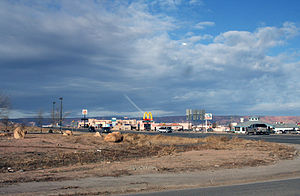The town of Moab, Utah deserves some mention. I wrote my first post about how the town has built an economy around outdoor adventure. Let me relate some anecdotes about our time there. I awoke early one morning, and as is my usual habit, I opened the drapes to look out at the sunrise over the parking lot. At the far end of the lot was a brand new Chevy Silverado with dualies, and a crew cab. Hitched to the truck was a twenty-four foot covered trailer. A forty-something man was up early unloading his rock climber; a special vehicle designed and built to climb ridiculously tough terrain. Later, after breakfast, I went to my car, and there, parked near my Death Star was the rock climber. The thing looked brand new. The young man was setting out on an adventure from the hotel parking lot. He would drive his unlicensed super-horsepower, four-wheel-drive, roll-caged, high-wheeled, wide-tired climber down the street to a trailhead. I thought this was unusual. The locals say it happens all the time.
After touring Arches National Park, we parked the Death Star on a side street and walked to the main drag. We passed a parking lot of Jeeps fitted with bench seats and special roll-bars. They were all the same color with a distinctive logo. The fleet was ready to haul tourists on back road tours through the scenic mountains. A half block further we passed a bicycle shop with mountain bikes galore waiting to buy or rent. Peg and I searched for a place to eat, and we passed many pasta cafe’s. Pasta is another sure sign of a young athletic type adventurer. Pasta is the fuel of bicyclists and hikers. We had lunch at Pasta Jay’s and were delighted by the menu which contained many non-pasta items.
Since Moab was a stop on our journey home after spending three and a half months in the Valley of the Sun, we did some last-minute souvenir shopping. I wanted to buy baseball caps with Moab printed on them for my male kids. We crossed Main Street from the pasta place to the T-Shirt Shop where if I couldn’t find what I was looking for it doesn’t exist on the planet. I didn’t find a hat with “Moab” printed on it. I asked the Gnarly looking kid behind the counter if he could make hats for me. “I sure can,” he said. We print anything you want on any of the hats on that rack there. He pointed at a wall display with hats in a variety of neon colors. “What about putting Moab on the hat?” He pulled out a box of ready-made appliqués and showed me several sizes of Moab. I picked one and told him to make nine hats in the flurescent orange and to add a jet black Moab to it. I want my team to have something that will make people ask “what the heck is Moab?” The clerk rattled off a couple of meanings instantly. He said, “If you are in the Air Force it means Mother of all Bombs, and if you are in the Navy it stands for Mother of all Boats, and I can sell you a special bumper sticker that reads “Mother of all B______,” where you fill in the b-word.
We talked to the clerk as he methodically applied Moab to the hats. We learned he was from Baton Rouge, Louisiana where he graduated from Louisiana State University (LSU) with a degree in Communications. To pay for his education he spent eight years in the military as a medic. Four of those years he spent in Afghanistan. I learned he was conservative, and he could not openly discuss his views while at work. He whispered that most of the thirty-somethings that come to enjoy Moab are Progressive-Liberals.
Scott’s real job was to use his distinctive voice and communication skills making radio commercials. This he did from his home studio. We became fast friends with him, and Peggy enjoyed telling him about her granddaughter who at age eighteen joined the Air Force to qualify for the GI bill.
We fell in love with Moab, and will return there to spend more time. I’d love to take a Jeep tour of the back country, and to explore Canyonlands National Park on the next visit. Just maybe, I’ll take a raft trip down the mighty Colorado River, solo of course.
Related articles
Filed under: Biography, Characters I knew, family, Travel | Tagged: Arches National Park, Canyonlands National Park, Colorado River, Death Star, Jeep, Moab, Moab Utah, Mountain bike, Pasta, Utah | 2 Comments »

























































